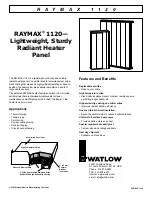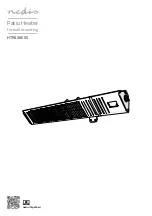
60
10
Operating information
Installation & Service Manual
Night setback
The Night Setback submenu is located within the Installer
Submenu. Access the Night Setback submenu by using the
arrow keys to select NIGHT SETBACK from the submenu
list.
This feature allows the user to lower the tank setpoint at
specific times throughout the week. The night setback
temperature value determines how much the tank setpoint
is lowered during the time when the feature is active. The
times at which the tank setpoint is lowered are controlled
by seven (7) start and seven (7) stop triggers. Each trigger
can be set to any time on any day. When the internal
clock reaches a start trigger, night setback will become
active. When the internal clock reaches a stop trigger,
night setback will become inactive. When a start and stop
trigger are programmed for the same day and time, the
stop trigger will have priority, so night setback will remain
inactive. (The default settings are all set to the same day
and time.) Use the following procedure to set up the Night
Setback feature:
Note: Any time the
◄
button is pressed during the Night
Setback menu, the current settings will be saved, and the
screen will return to the Installer Submenu list. To re-enter
the Night Setback menu, simply select Night Setback from
the Installer Submenu and use the
►
button to advance
through until the desired trigger is reached.
1. Access the Night Setback submenu within the installer
menu and select the desired Night Setback temperature
using the
▲
and
▼
buttons.
2. Press the
►
button to advance to the next screen. This
screen will display the default settings for the first
Night Setback start trigger.
3. Use the
▲
and
▼
buttons to select the day of the week
for the current trigger, then press the
►
button to
move to the time selection.
4. The time for the current trigger is displayed in a
12-hour format with the hour digits flashing. Use
the
▲
and
▼
buttons to adjust the hours for the
current trigger, then press the
►
button.
5. The minutes digits will then start flashing. Use the
▲
and
▼
buttons to adjust the minutes for the
current trigger, then press the
►
button.
6. The AM/PM selection will then start flashing. Use the
▲
and
▼
buttons to select the appropriate AM/PM
setting for the current trigger.
7. Repeat steps 2 through 6 to set day and time for
all necessary start and stop triggers. Once all necessary
triggers have been set, press the
◄
button to exit the
Night Setback menu.
GENERAL submenu parameters
TIME / DATE
The water heater control uses an internal clock for the night
setback feature and for logging events. For these features to
work properly, the clock must be set when the water heater
is first installed or when the water heater has been powered
off for more than 15 minutes. Note that the internal clock
does not adjust for Daylight Savings Time and therefore, will
require a manual adjustment.
TEMPERATURE UNITS
This controls the units in which all temperatures will be
displayed.
MAX SETPOINT
The max setpoint should be set to the highest hot water set
point that can be used for the specific domestic hot water
system. This parameter is the upper limit of what the user
can adjust the TANK SETP parameter to.
MRHL SETPOINT
The MRHL SETPOINT sets the heat exchanger outlet
temperature at which the Manual Reset High Limit action
occurs. If the heat exchanger outlet temperature continues to
increase after automatic reset high limit action, and beyond
the MRHL SETPOINT, the Manual Reset High Limit action
occurs. This will require a manual reset before operation can
resume.
TANK SETPOINT DIFF
The tank setpoint differential sets the number of degrees that
the tank sensor must read below the tank setpoint for the
water heater to begin firing.
TANK SETPOINT OFFS
The tank setpoint offset sets the number of degrees that the
tank sensor must read above the tank setpoint to satisfy the
hot water demand.
PUMP DELAY
The pump delay time sets the length of time after the hot
water demand is satisfied for which the pump will run. This
feature allows the pump to run for a length of time after the
unit has fired in order to cool the water coils inside the heat
exchanger.
















































